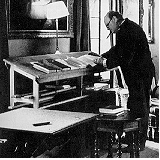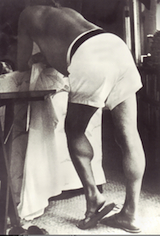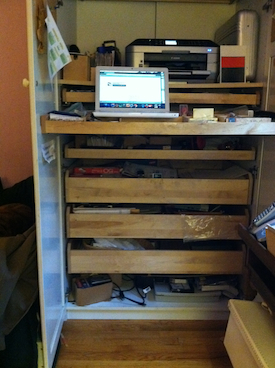Attention content marketers, copywriters and editors: your career is deadly.
No, it’s not Content Shock. It’s not brutal deadlines. It’s not difficult clients, writer’s block or social isolation.
It’s sitting.
Study after study confirm that sitting is bad—very bad—for your health. In addition to putting you at risk for a range of diseases and conditions, sitting for long periods of time also (gulp) increases your risk of death.
Stand up for yourself.
That’s the bad news, now the good. You can reduce health risks significantly by making a few changes in your daily routine: taking mini-breaks, sitting on a stability exercise ball, or—best option—working at a standing desk.
You stand in good company.
If you read tech and productivity blogs, chances are you’ve heard about standing desks. The waist-high tables and lecterns, however, weren’t invented by hipster knowledge workers. They have a venerable history.
Nineteenth century office workers toiled at standing desks. Winston Churchill worked at a standing desk.

Charles Dickens wrote at a standing desk and so did Ernest Hemingway—though Papa seemed to lean more than stand.

But if you’re like me, the ghosts of statesmen and literary giants aren’t enough to make you rise from your comfy, comforting chair.
I had to read the alarming facts—and learn I was a prime candidate for serious health problems. Until recently, I sat for eight and sometimes 10 hours a day.
My slide to hell began in a chair.
When I started content marketing 20 years ago, I worked part time. I sat at a desk for a few hours a day. The rest of my time was spent sprinting after my three young children. But as the adorable toddlers morphed into charming tweens and then into sarcastic, condescending, thankless more independent teenagers, my work became fulltime.
I spent increasingly long hours hunched in front of a computer, motionless. Sitting. And sitting. And sitting.
I didn’t need an inactivity expert—yes, these medical specialists exist—to tell me sitting was unhealthy. Along with muscle cramps and lower back pain, I once pinched a neck nerve that required medical attention.
But the worst part? Weight gain. I’d been slender all my adult life. Now, without changing my eating or exercise habits at all, I’d packed on 15-20 pounds.
A spare tire and a big butt, however, should be the least of my worries—and yours.
If you sit, you’re a sitting duck for serious health problems.
Bipeds aren’t built to sit. We’re genetically programmed to move around on our feet. Our bodies work best and last longest when we use our muscles and circulatory system—if not to hunt and gather, then at least to putter in the garden and play sports.
But evolution is a cruel jokester: Today, the more harried our lives, the less we move. And we pay dearly for our immobility.
Health risks associated with long-term sitting
Recent studies tell us:
- Sitting shuts down your body systems. Motionless in a chair, your body’s “muscles go as silent as those of a dead horse”. Muscular electrical activity drops, fat-busting enzymes decline by 90% and HDL cholesterol—the “good” kind—plummets. Associated diseases and conditions occur regardless of our age, weight, smoking habits or alcohol consumption.
- Sitting increases your risk of death. Women who sit for more than six hours a day have a 37% higher chance of dying of a variety of diseases than women who spend less than three hours sitting. Risk of heart attack and death from coronary disease doubles for people who sit for long periods of time.
- Exercise doesn’t help. Think yoga, a 5-mile run or that Crossfit class offset the danger of sitting all day? Sorry, but no. Research shows that regular exercise does little to counteract the dangers associated with sitting.
Little movements make a big difference.
If exercise doesn’t help, what does? Little things, say scientists: Small shifts in posture—stretching, shifting weight—and tiny movements such as tying your shoelaces are enough to activate your body.
By far the best thing you can do for your health, however, is to stand while working. As you stand, your body makes small movements and muscle adjustments constantly to keep electrical and circulatory systems humming.
For the last month, I’ve been writing at a standing desk. I now stand for at least four hours a day while I work and am increasing my standing time incrementally. But the transition wasn’t easy for me.
Six suggestions for success working at a standing desk
The first few days working at my standing desk, I was irritable and distracted. My legs and feet ached badly. But by trial and error, I found ways to make standing work easier.
Some of the following suggestions may also help you:
- Ease into standing. Don’t set unrealistic goals. Lasting habits form best slowly and incrementally. Try standing for half an hour—or less—the first day. Once you’ve worked up to an hour, stay at that level for a week. Then add half an hour. Now stay at that level for a few days before adding more time.
- Work with your body’s time clock. Start your standing work when your body feels rested and energetic. For most of us this is in the morning hours. I find it almost impossible to stand and work after eating lunch and in the late afternoon.
- Stand for less focused work. In the beginning, I was unable to write first-draft copy—the part of my work that requires the most concentration—while standing. So I stood while working on less focused activities: Internet research, note taking, revisions, photo editing, email and social media.
- Lean. If it’s difficult to stand straight the whole time, do as Hemingway did: lean. Since your body is still shifting and moving minutely, you’ll enjoy many of the benefits of standing.
- Rest your foot or knee. This minor adjustment relieves a surprising amount of tension and strain. Some fancier standing desks have built-in footrests. Or you can improvise your own footrest with a box or low table.
- Use a high stool. Nineteenth century offices often had high chairs or stools so workers could take a break from standing by leaning or sitting on a perched seat.
Find a standing desk that suits your taste and budget.
Once you decide to give standing desks a try, you’ll find no shortage of options, from antique reproductions to Rem Koolhaas-style desk extensions. Here are some of my favorites:
A desk of one’s own—the Virginia Woolf Edwardian standing desk from Stand Up Desks. I also love Stand Up Desk’s Georgian model—with handy footrest—and their 3-in-1 Da Vinci, a $1,400 splurge.
Giraffe Desk, a handmade acrylic desk extension. The Giraffe Desk sits on top of your traditional desk, raising your work area to waist height. Available in two sizes to hold a desktop or laptop computer, paper and all the other detritus you need to work.
Treadputer. Exercise addicts will love this combined treadmill/computer set-up that lets you walk, jog or full out run while you work.
DIY standing desks. Not ready to shell out hundreds or thousands of dollars on a health experiment? You can easily rig your own standing desk from furniture and odds and ends around the house. Try putting your laptop on a low bookcase or—as I did, below—a rollout shelf. Place a table on top of another table—see my lectern-on-coffee table, below. Use an ironing board. Stack a series of boxes. For more DIY ideas, check out Bob Vila’s site.
Still can’t stand standing?
If you simply hate standing to work, at least try making healthier adjustments in your daily routine:
- Exercise vigorously and regularly. Aerobic activity and weight-bearing exercise won’t eliminate health risks associated with sitting. But exercise does improve your circulation, muscle tone and overall health—and perhaps makes it easier for you to attempt standing work later.
- Take breaks from sitting. Use a timer or, my favorite, an hourglass. Once an hour, drag yourself away from the magnetic computer screen and stand up. Even if only for a few seconds.
- Stretch. While you’re on your feet, do some shoulder and neck rolls. Bend down and touch your toes and do some lateral leg stretches.
- Sit on a stability ball. Instead of hunching over your desk in a traditional chair, substitute an exercise stability ball. Without being aware of it, you’ll sit up straighter, use your stomach muscles and make countless minute adjustments that keep muscles active and heart pumping.
Avoid turning into “sitting meat.”
According to writer George Pendle, Gustave Flaubert hated working on his feet. “One cannot think and write except when seated,” Flaubert wrote to his protégé, Guy de Maupassant. “A civilized person needs much less locomotion than the doctors claim.”
But Friedrich Nietzsche disagreed vehemently. Hearing of Flaubert’s penchant for lounging on the job, Nietzsche declared the author of Madame Bovary a “nihilist…. The sedentary life (das sitzfleisch—translated, “sitting meat”) is the very sin against the Holy Spirit.” (Presumably Nietzsche passed judgement before declaring God dead.)
May all of us be redeemed from das sitzfleisch.
References:
The New York Times
Scientific American




What a brilliant idea. So simple, yet so effective. When we were children we use to stand to paint and to draw, but not to write. Why?
I might give this a try. I’ll let you know if I do.
@Ben: Yes, let me know if you try it, Ben. As mentioned, the transition was tough for me. For at least a week, I was in real pain and doubted I’d ever be able to stand and think at the same time. Much better now!
We’ve already been researching ways of converting our desks – you’ve tapped into a vein of enthusiasm here. We’ll let you know how we get on!
I tried standing to work some time ago, but the sheer protest from my back (which ached soooooo much, due to an old injury) that I slumped back into my chair before long. ;0)
But a great article and reminder to keep moving…
Urgh, should have proofed before i posted! Proof that my own penchant for lounging on the job is bad!
@Tracey: Don’t beat yourself up–the first version of this post went up with typos. And don’t give up on standing to work. I urge you to give it a try—slowly—a little later.
I’m afraid I’ve spent my entire inventory of superlatives on you, Lorraine.
All I have left is: thank you for this doubleplus good thing. 🙂
Well I’m standing to read and write this post which is a start! I never knew sitting was so bad, nor that exercise didn’t really counteract it.
I used to sit on a ball but was talked out of it (and found it too hard to balance while pregnant then breastfeeding!) and have gotten used to a chair – time to pull the ball back out me thinks.
When I was young, I kept a small ball under my desk and used to roll it around under my feet whilst studying so I guess that was more beneficial then I ever knew, too – I’ll reintroduce that too while trying to adding staring to my writing day.
Thanks for the info and inspiration Lorraine (and thanks for the link, Paul)
@Paul: YOU at a loss for words? Impossible. Thanks for coming by to comment. : >
@Tash: You are most welcome, Tash. Thanks for taking time to comment. I know, it is hard to believe that sitting has such profound impact on our health. The research is pretty persuasive, however. At least it persuaded me. I feel like an evangelical stander—gotta spread the word!
Thanks for this awesome post! After a few years of extensive sitting, I also became concerned about the health problems it was causing. Now my husband and I are walking 2-3 miles almost every day. To fix the desk problem, I found a good box and turned it upside down on my desk. Wa la! Standing desk.
: )
@Beth: Thanks for your kind words, Beth. I’m glad your box desk extension is working well. It’s amazing what you can come up with using simple things from around the house. My husband just added dowel extensions and rolling wheels to a wooden lectern. Now I can roll it from place to place. Will try to post a photo of it later!
I think I’ve developed ADD, so I rarely spend more than 1 hour at a clip sitting at my desk. I have to go up a flight of stairs to make a cup of tea, and I take frequent breaks – including blasting music really loud and dancing for 10-15 minutes. It’s good for the body, soul and annoys my kids. (“Mom, can you turn your crappy old music down, please!”)
Gotta love it.
Oh, Lorraine, this post is right up my alley, as a Chiropractor-turned-desk-hugging-blogger. In all the years of adjusting patients, which is physically exhausting, I never had a back problem. Now that I’m sitting most of the day, my back goes out more often than I do. I joked that it was because of my getting older but I don’t think so. 🙁
I am thinking of buying an inexpensive drafting table. Architects and graphic artists must know something about sitting prolonged time causing health problems since drafting tables are always at standing heights and you need the high stools that you have to perch your buttskies and not exactly sit, fully. (Off to check Craiglist or Freecycle.)
I want to add one comment about the foot rest you mentioned. Putting one foot on a stack of phone books (if you still have any) or a small box is VERY important when standing for prolonged period of time. It softens the curvature in your low back – reduces lordosis – and puts less stress on the low back muscles. You can switch your foot once in a while so that you are not leaning on one leg, which can cause additional problems down the road. This is a single most important thing to do when you are standing for a long time, including cooking. (You can open the under the sink cabinet door to do this when you are cooking.)
Off to share this wonderful post with all my blogging friends. Thanks Lorraine!
Wow! This is a must-read. You’ve got me convinced! I’m going to try this out tomorrow.
Thank you so much for sharing this, Lorraine!
Wow, this is food for though.
I worked alongside a graphic studio for several years in the early 90s, when graphic design still included work by hand, and those guys stood at their drawing boards (though stools were available), which was essential for getting the long sweep of a logo right. The artists had a much more physical relationship with the work than me with my tappity tap tap and I’m sure better blood flow to the brain because of it. The stand up desk is a new concept to me, but we’re getting new furniture soon at Push (and a new building!) so I might add drawing board to the mix so I can stand as I work, and in the evenings work on my charcoal portraits – obviously ;).
I love the idea of a standing desk. To be honest though, the reality of it sounds dreadful … can’t imagine it would be comfortable or productive. I guess it just takes time to get used to it. But I’m sure that sitting for hours and hours each day is horrible for our health.
Next problem to deal with: staring at computer screens for so many hours each day. That must be murder on our eyes.
In twenty years the entire population of the working world will be hunchbacked blind moles dragging their atrophied legs along the ground and speaking into voice recognition software to type because we can’t even see the pixels on screen anymore.
I’ve already felt concerned when looking back at the effect on my body of constant sitting and like some health-Scrooge I hear your piece as a warning from the Spirit of Ailments Yet to Come.
All very true, Lorraine. Thanks for those suggestions. The standing desk sounds eminently sensible, though mildly alarming at the same time, cutting as it does against everything we’ve been brought up with.
It’s disconcerting to realise just how unhealthy copywriting is. I should have been a lumberjack. Then I’d have been okay.
Thank you for reminding me that sitting all day is such a health risk. As I type this, I am standing at my desk – honouring your post and beginning to take better care of my health. Excellent post!
You are in so much trouble. The morning I read this post, I was so paranoid about sitting all day that I got up every 30 minutes, took two additional walks outside and tried to work standing up. End result? Almost NOTHING accomplished.
That’s when I realized that if I eek out an additional 10 years of life, but have to spend the next 50 popping around like a whack-a-mole part and not doing the things I enjoy…I don’t want to live the additional 10 years. I’ve been sitting contentedly ever since ;-P
And you may thing I meant eke out…but I actually screamed like I saw a mouse and meant EEK! out. So there 😉
@Roberta: I applaud you for climbing the stairs to make a cup of tea. I’m so lazy–er, that is, I concentrate so deeply!!–I would’ve installed an electric kettle long ago. Dancing is a great idea. Don’t listen to your kids–what do those young whippersnappers know about good music?
@Karen: If anyone should know about back health, it’s you, Dr. K. It’s funny how unconscious we are of something that’s really so obvious. The research convinced me–it wasn’t one isolated study after all. A drafting table sounds like a great idea. A tall stool is fine too, as long as you’re not slumped in it the whole time. As the research notes, it’s all the tiny movements, tensions, releases and flexing that, cumulatively, keep systems in good health. Thanks for the note on the footrest. In addition to providing all the benefits you mention, a foot–or knee–rest provides an amazing amount of relief from the fatigue of standing.
@Jeff: You’re very welcome, Jeff. Take it slowly–I was exhausted when I first tried it and really despaired of it working out. Now, as mentioned, I’m up to four hours and it’s pretty painless.
@Angpang: New desks and a new office, Angela? Squee! I’m jealous. It would be great if you had a few workspace options. I know esthetics are important to you (me, too) and there are a number of great looking drafting and drawing tables that don’t cost an arm and a leg. Also think about adapting traditional tables and small desks. I’ll post a photo on Instagram of the lectern my husband just a adapted for me.
@B: Haha! Enjoying the image of hunchbacked mice speaking into voice recognition software. As I type this, I’m lying on a sofa, having already put in four and a half hours standing this morning. Honestly? I’m most comfortable slumped on a chaise longue, laptop propped up on my knees. If only it didn’t make one fat and sickly. But it does, so I’m standing and trying not to grumble. Too much. Seriously, though: You build up stamina over time.
@David: Regarding the “Spirit of Ailments Yet to Come”: Likely I’m older than you as the ailments are already here. I like your lumberjack idea. And the wool plaid shirts are au courant right now as well…
@Dawn: Good for you for, er, standing up for yourself… : >
@Yo. Don’t hurt me. I didn’t conduct the studies, I just reported on them. I could relegate you to the Gustave Flaubert School of Writing, but I’m not gonna: I care too much about you. If you can’t stand standing, I hope you’ll try some of the alternatives: taking breaks, stretching and maybe even the balance ball.
@B.Ligerent: That is, hunchbacked moles. Even better. Chortling.
BTW, Looking forward to exploring your website and it’s spirited copywriting tips.
Thanks! You’re welcome there any time.
Stumbled on this researching Facebook updates for a woodworking client, and thought of you.
The Deadline Desk. Add a timer controlled padlock on the side.
http://www.custommade.com/tabledesk/by/bwtribblewoodworking